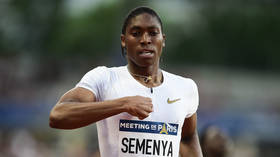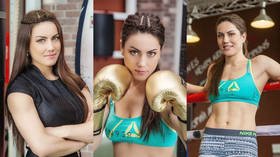The battle of testosterone that will decide the fate of sport: The curious case of Caster Semenya

Imagine you are a male athlete, striving for success in sport. But, for one reason or another, you fail to bring home medals. What would you do? You can always quit and try to do something else.
However, soon you might have another perfectly legal and, as things are going, publicly acceptable option – declare yourself a woman and compete against female athletes. You even have the option of going back to being a man later. No, I am not directly implying that this would make things easier and you would immediately win accolades – it largely depends on the sport – but the fact itself that you are likely to have those options is bewildering, to say the least.
Ouch. I can imagine that merely by suggesting this I may be branded a “transphobe” and have abuse hurled my way from the LGBT world. Well, let me disappoint those looking for a fight – I respect every person’s gender or sexual preferences. But what I also respect just as much is fairness in competition – free from any form of cheating and unnecessary controversies.
So does the tennis legend – 18-time Grand Slam winner – Martina Navratilova. It was easy to foresee back in December last year that she would not get a pass with her comments about transgender athletes.
Also on rt.com ‘Having a penis and competing as a woman is not fair’: Navratilova inflames transgender fury“You can’t just proclaim yourself a female and be able to compete against women. There must be some standards, and having a penis and competing as a woman would not fit that standard,” she tweeted back then. It sparked a ferocious online verbal brawl with transgender world cycling champion turned academic Rachel McKinnon. She was called a “transphobe” and was forced into an apology, with a promise “to read up on the matter.”
The queen of tennis was known for many spectacular comebacks – and this was just another one, although it happened off the court. Last weekend, after two months of silence, she hit back with a whole article for the Times, saying not only that she stood by her original comments, but that her views have been strengthened after researching the issue.
“A man can decide to be female, take hormones if required by whatever sporting organization is concerned, win everything in sight and perhaps earn a small fortune, and then reverse his decision and go back to making babies if he so desires. It’s insane and it’s cheating,” wrote Navratilova.
“Simply reducing hormone levels – the prescription most sports have adopted – does not solve the problem. A man builds up muscle and bone density, as well as a greater number of oxygen-carrying red blood cells, from childhood. Indeed, if a male were to change gender in such a way as to eliminate any accumulated advantage, he would have to begin hormone treatment before puberty. For me, that is unthinkable,” argued the tennis legend.
You probably don’t even need to guess what kind of reaction from the same people she sparred with online in December this article entailed. Because it’s quite obvious – more accusations of being a “transphobe,” more abuse from keyboard warriors and, in the latest development, Navratilova’s removal from the advisory board of New York-based Athlete Ally group, which supports LGBT athletes.
Also on rt.com LGBT group cuts ties with Martina Navratilova over ‘cheating’ trans women commentsI find it all extremely hard to fathom – especially since we’re not only talking about a superstar former athlete, who I grew up watching and admiring, but also one of the first high-profile athletes to take a leap of faith and come out as gay. As early as in 1981, when – let’s put it this way – the times were very different. And all for demanding fairness in a competition, while clearly stating that those vilifying “athletes who wanted to be different” had no place in the society.
In a way, Navratilova preempted this fresh avalanche of criticism. In that article, she wrote that “Certainly, there can be no excuse for such ignorance and nastiness. But I also deplore what seems to be a growing tendency among transgender activists to denounce anyone who argues against them and to label them all as ‘transphobes.’ That’s just another form of tyranny.”
And I could not agree more with all points made by Navratilova. For one very simple and obvious reason, amply stressed by her, men and women are different, whether you like it or not. Irrespective of where our political or social allegiances lie, irrespective of how we want to be defined – legally or mentally – our bodies are different. With minor biological exceptions, we develop differently. And demands on both should be different – so why is the world so hellbent on moving these goal posts?
I don’t want to go into lengthy discussions about how the world is gradually losing its mind, time and efforts in endless and unnecessary on-and-offline “political correctness v reality” wars. But I want to stress again – a competition must be fair and clean, if it is to be enjoyed. And the persistent inability of the people to work out compromises definitely doesn’t help that.
Since the notion of “transgender athletes” appeared in the public domain – brought in by transgender tennis player Renee Richards back in 1975 – this has been the subject of never-ending controversy and debate. But now things are heading to what could be a culmination of decades-long deadlock. That is through the ongoing legal battle between South African runner Caster Semenya and the International Association of Athletics Federations. Last year, after IAAF introduced the controversial limit to testosterone levels of 5.0 nanomols per liter of blood for female athletes. Many regarded this as an attack on innocent athletes.
Caster Semenya is an absolutely brilliant talent, a one-in-a-generation athlete, and she has done nothing wrong. She has never failed a doping test and it’s not her fault that she was born with a relatively rare condition – hyperandrogenism. That’s when one’s body produces more testosterone than it should. Whether or not this condition gave her a sporting advantage is still unclear. There is no direct scientific proof of that, and numerous works have both supported and contradicted such a view. All that’s left to do is to speculate whether the higher level of “male” hormone in her blood somehow affects her and other athletes’ performances. Just as her refusal to chemically suppress the hormone’s level – something suggested by scientists as a solution to the issue – could also be the subject of lengthy scientific and academic debates.
While it’s very easy to bash the IAAF’s decision as “illegal, discriminatory and inhumane,” however, as many LGBT groups worldwide were quick to do, it is much harder to see if from “the fair sport” perspective. It goes without saying: the IAAF’s ruling was destined to open a can of worms and generate massive backlash from human rights groups. This was primarily because, these days, there’s such thing as “legal recognition as female.” But was the federation completely wrong in taking a step in that direction? The step was probably flawed in its implementation, but not so wrong in the general idea – rooting out unfair advantages in sport.
As things stand, however, the situation looks utterly ridiculous and almost hopeless for both sides. A big fat burger of absurdity. Underneath is the actual physical anomaly, which is yet to have any concrete and viable scientific proof of providing any advantage; on the top is the vocal outcry from human rights and pro-LGBT groups about discrimination. Sandwiched in between those two “buns” is the willingness of athletes and sports officials alike to see clean and fair sport. For now, this looks indigestible – with both sides of the argument refusing to hear one another, resorting to toxicity and abuse towards one another. There’s no room for compromise either – such as, potentially, creating a THIRD category for athletes. The whole world is OK with sport being divided into male and female categories – so why not give the athletes a separate category for transgender competitors, where they would be able to compete against each other, thus nullifying any notions of discrimination? Yet that opinion, for no particular reason, is also seen as discriminatory and is pushed to the far fringes of this debate.
That is why the imminent decision in Lausanne by the CAS regarding Caster Semenya’s case could be pivotal for sport, like the Bosman rule, which changed the face of football back in the day. And given the hype and vitriol surrounding it, I find it almost impossible to see a scenario in which everyone wins. If the court upholds the IAAF’s ruling, Caster Semenya would probably be forced into early retirement and immediately becomes a martyr-like figure for the transgender sports community. If the testosterone limit gets scrapped by the court, the scenario which I mentioned at the top of this op-ed becomes reality, effectively killing what remains of fair and clean sport.
Wherever it goes, the CAS decision will have huge implications. Even the International Olympic Committee says it will wait for that verdict to decide on its policies towards transgender female athletes at the Tokyo 2020 Olympics.
The fateful verdict is expected to come out in March.
By Alexey Yaroshevsky, RT’s sports reporter
Follow him on twitter @YaroLFC
Like this story? Share it with a friend!
The statements, views and opinions expressed in this column are solely those of the author and do not necessarily represent those of RT.















